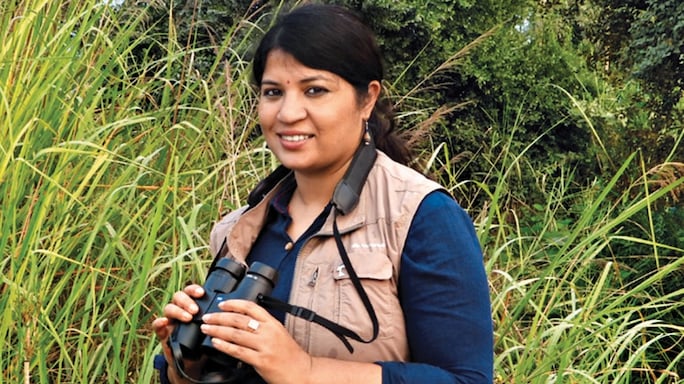- HOME
- /
- Everyday Heroes
- /
It Takes A Village: The all-women volunteer corps that saved an endangered bird
How a biologist mobilized an all-women volunteer corps to champion an endangered bird
 Purnima Devi Barman
Purnima Devi Barman
Wildlife biologist Purnima Devi Barman (42) remembers the first time she ever saw the nest of a greater adjutant stork. The birds had made their home in the broad branches of a tall, old kadam (burflower) tree that stood near her grandmother’s home. As a five-year-old, the tree was one of her favourite places to play, and she would spend hours sitting under its shade, gathering its fallen blossoms and birdwatching, “My grandmother would tell me stories of Lord Krishna and Radha courting under a kadam tree. I loved that tree and the peace I felt sitting under it. I remember being terribly distressed when it was felled.”
For Barman, nature, both its vagaries and its abundance, were an integral part of her world. Her father served in the army, so Barman was sent to live with her grandmother in Pub Mazirgaon, a village on the banks of the Brahmaputra. Young Barman was inconsolable at being separated from her parents, so, to keep her occupied, her grandmother would take her to their paddy fields and tell her stories about birds and animals. The love for the natural world she developed in those years left a lasting imprint, one that led Barman to devote her life to wildlife conservation—specifically saving the endangered greater adjutant stork.
Known as the Hargila (meaning bone-swallower) in Assam, the greater adjutant stork is the second-rarest stork in the world. At fewer than 1,200 individuals, this species currently stands at less than one per cent of their numbers a century ago. Their dwindling population is largely driven by global warming and human activity that has destroyed the wetlands where they forage. Rapid urbanization has also led to loss of nesting trees. Unlike charismatic megafauna, such as the giant panda or lions, whose attractive appearances help garner widespread support for their protection, these tall, bald, ungainly birds with their spindly legs that move in a stiff, military gait (hence, the prefix ‘adjutant’) and elongated yellow-orange neck with an inflatable throat pouch suffer from a bias in conservation campaigns. “Hargilas also bear a reputation of being ill-omens. Their dietary preference for carrion and their foul-smelling droppings add to the local population’s distaste,” says Barman. It was her first-hand experience of the repugnance with which the species is treated that sparked her pivot to working on championing the Hargila.
In 2007, Barman, who was then working on her PhD about these birds from Gauhati University, received a call from a contact: A villager was felling a stork nesting tree on his premises in Dadara. She rushed to the site, where the sight of nine broken nests and the dead and injured chicks broke her heart, “My twin daughters had just turned two and I think my maternal instinct kicked in. I wanted to do some-thing to protect these babies.”
An emotional Barman engaged with those who had gathered to talk about the importance of the storks and their nesting trees: As natural scavengers, they clean their environment and maintain ecological balance. But who was she to tell them what to do with these ill omens? the locals countered. Would she turn up to clean up the mess these pests created? This harrowing exchange led to an inner shift. “What was the point of writing my thesis on them, if there was no way of actually saving these birds? I had to start with changing the perception that the birds were bringers of pestilence, and bad omens.” Not one to shy away from a challenge, Barman put her PhD on hold and set to work. Her experience of volunteering with Aaranyak, a Guwahati-based wildlife NGO, where she is now a senior project manager, had taught her the value of community participation.
 The support of local women, says Barman (seen here in blue) is the key “to build anything sustainable,” and critical to the success of her campaign to save the greater adjutant stork
The support of local women, says Barman (seen here in blue) is the key “to build anything sustainable,” and critical to the success of her campaign to save the greater adjutant stork
“I started engaging with the women in the village—the men tended to react with derision or dismissal. In our experience, educating and securing the participation of women ensures that the learnings pass on to the next generation. That’s the way to build anything sustainable,” Burman says. This led to the creation of the, now 10,000-strong,all-women Hargila volunteer army to help save this vulnerable species.
Through programmes celebrating landowners who allowed nesting trees to continue growing on their property, cooking competitions in backyards, and several other such events, Barman began to spread the word and draw community support. “I finally broke ground at a baby shower I organized for the Hargila mother where woman attendees no longer looked at me with awkward, uneasy glances. Their smiles had turned warm, even empathetic,” she recalls. She started visiting naamghars (prayer houses), wherewomen would make offerings for their child’s success and well-being. “I started the same for the Hargila during its breeding season,” says Barman.
A decade of community mobilization, pledge programmes and public meetings later, slowly yet surely, Barman’s army grew. Today, around 400 women have been trained to actively campaign and work on conserving this rare bird. The group’s activities include awareness-building in schools and plantation drives in which 45,000 saplings were sown near nesting trees to support the stork’s future populations. In 2017, they started an assisted breeding program, building tall bam-boo platforms where the birds could nest and hatch their eggs.
 The Greater Adjutant Stork
The Greater Adjutant Stork
A key component that allowed Barman to successfully integrate conservation efforts into the village cultural life was her idea of building related livelihoods. Weaving is a long-standing craft in Assam, so Barman secured a government donation to procure 30 high-tech looms and good quality yarn and created a self-help group that employed women to weave stork motifs on textiles. Eighty women were also given sewing machines to make bags, cushion covers and other items from the handwoven fabrics. This “entrepreneurial vision” in marrying conservation efforts with an economic incentive was highlighted at the UN Champion of the Earth Awards, which she won in 2022. She also received the the Whitley award and the 2017 Nari Shakti Puraskar, the highest civilian award for women in India.
Currently, the number of greater adjutant nests in Dadara, Pacharia and Singimari villages in Assam’s Kamrup district has grown from 28 in 2010 to more than 250, making it the largest breeding colony of greater adjutant storks in the world. The once reviled stork is now a symbol of community pride, its likeness appearing on henna motifs, celebration decor and even in devotional songs.
Despite the acclaim, Burman stresses that the work is an ongoing, uphill battle. “It often feels like a snakes-and-ladder game, where the next roll of dice could take you crashing back to where you started”, she says. The pandemic was one such instance, “Rumours were rife that the storks were carriers of the coronavirus. I was confronted by a mob when I went back to the field after mobility restrictions were relaxed.”
Patriarchal attitudes have been another hurdle: “My professors would reiterate how essential it is for women to enter this field. But once you do, one discovers how the system makes it very difficult for women to sign up and flourish”. Barman’s claim is easily illustrated by the results of a 2020 international survey of 6,241 rangers in 26 countries—just 7.5 per cent of the workforce was female. But Barman isn’t one to lose resolve. “I’ve always believed that, if given a chance, women can make a big difference in conservation.” Surely, her own journey is testament enough.





